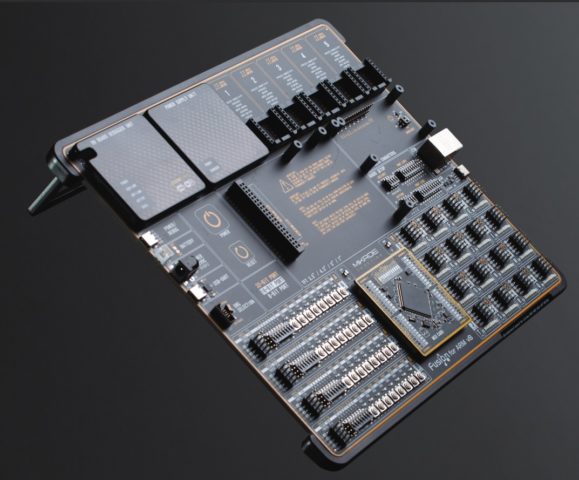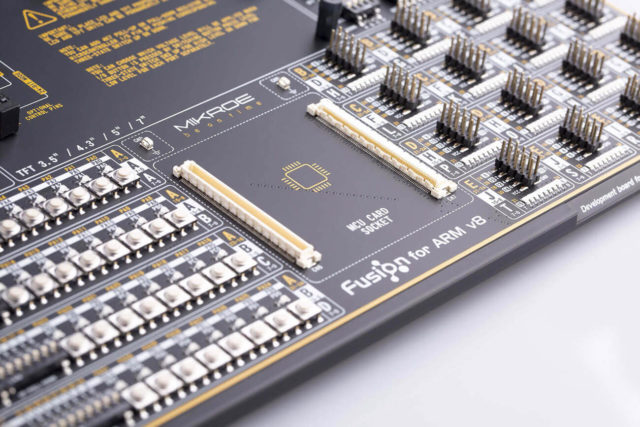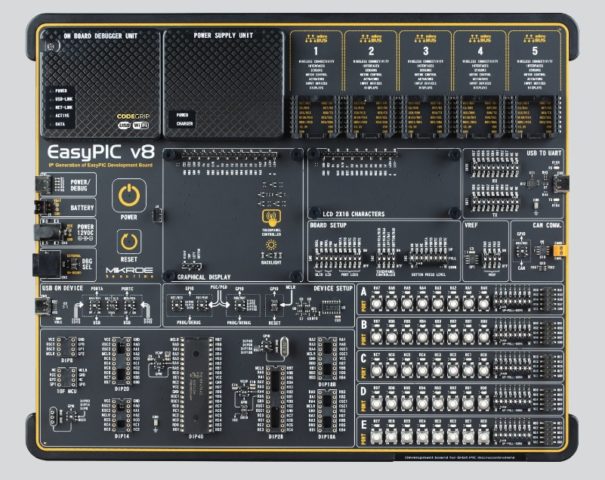During Embedded World 2020 (EW2020), some companies withdrew their presence, while some were at the event. MikroElektronika presented several new boards and among them Fusion for ARM v8 and EasyPic v8 development boards. While we already wrote about Fusion fo TIVA, we haven’t covered any EasyPic board yet. Development boards from MikroElektronika allow rapid prototyping in the most efficient and effortless way.
Fusion for ARM v8
Fusion for ARM v8 belongs to the Fusion family of development boards. It has integrated the world’s first embedded debugger/programmer over WiFi, while the CODEGRIP WiFi license is available as an add-on feature. The board is designed to be used in almost every environment retaining full debugging and programming access. The CODEGRIP currently supports more than 1600 microcontrollers from different vendors.

The Fusion board integrates a new MCU card standard. It is a low profile standard where sockets consist of two connectors (male/female) which prevents the wrong insertion. The MCU card has standardized dimensions and supports various numbers of pins. This allows flexibility in the selection of the MCU type. The MCU card supports multiple ARM MCU families: STM32, Kinetis, TIVA, CEC, and MSP, while support for more vendors is coming.

As a new feature on Fusion for ARM, there is a display connector that allows different screen sizes and technologies. Currently, the board supports TFT capacitive screens, but in the future, we can expect OLED and E-ink. MikroElektronika’s mikroBUS sockets allow the use of any of 650+ Click boards from the company.
Fusion for ARM v8 specifications:
- ARM (32-bit) architecture
- MCU – Socket for MikroElektronika MCU CARD
- Display Interfaces
- 2x 20-pin TFT display connector
- 1x 16-pin LCD connector for 2×16 characters LCDs in 4-bit mode, optional PWM backlight driving feature
- Programming – On-board CODEGRIP programmer/debugger, JTAG connector for connecting an external programmer/debugger
- USB & WiFi debugger
- Connectivity – Ethernet port, WiFI in CODEGRIP programmer/debugger
- USB – 1x USB port, 1x USB-UART
- Expansion
- 5x MikroBUS Sockets for Click add-on boards
- 20x 2×5-pin headers
- CAN on the MCU CARD if available
- Misc – POWER and RESET touch-sensitive buttons, LEDs for each individual I/Os,
- PSU module
- Multiple power sources: LiPo or Li-Ion battery, external 12V power supply via a 2/6.5mm power jack, and power source over the USB Type-C connector.
- Support for power OR-ing function for uninterrupted operation
Currently, the Mikroe gives 20% off the development board, so the price is now roughly $359. To understand the costs of the system, the STM32 ARM-Cortex M0 MCU card starts from $28, while Click Boards can go from some $5 to much more depending on the sensor/device on it. You’ll find more details on the product page.
EasyPic v8
EasyPic v8 is a member of the 8th generation of Mikroe development boards. The board has the same CODEGRIP on-board for programing and debugging over WiFi or USB. The CODEGRIP allows access anywhere, at any time. The board offers programing and debugging for more than 270 Microchip’s PIC MCUs from 8-bit to powerful 40-pin MCUs. All PIC MCU sockets are at the bottom of the board. The board itself comes with a PIC18F47K42 and an 8 MHz crystal oscillator. There are eight different DIP sockets from DIP8 to DIP40, but only one MCU can be installed at a time.
The MCU cards are supported on EasyPic Pro v8, which is similar to Fusion for ARM.

The EasyPIC v8 is a development board that comes with two display connectors. One is a 16-pin LCD connector, and the other is a 20-pin header for GLCD and TFT. As a Mikroe standard board, there are five improved mikroBUS sockets that can be used for more than 650 Click boards. The power supply is uninterruptable with a wide range of power sources: external 12VDC, USB-C, and a Li-Po/Li-Ion battery.
EasyPic v8 specifications:
- PIC (8-bit) architecture
- 8 DIP PIC sockets
- Display Interfaces
- 1x 20-pin TFT and GLCD display connector
- 1x 16-pin LCD connector for 2×16 characters LCDs in 4-bit mode, optional PWM backlight driving feature
- Programming – On-board CODEGRIP programmer/debugger, JTAG connector for connecting an external programmer/debugger
- USB & WiFi debugger
- Connectivity – WiFI in CODEGRIP programmer/debugger
- USB – 1x USB port, 1x USB-UART,
- Expansion
- 5x MikroBUS Sockets for Click add-on boards
- 2×5-pin headers for each Port
- CAN on the MCU CARD if available
- 8 buttons for each Port
- 8 switches for each Port (pull up/down)
- Misc – POWER and RESET touch-sensitive buttons, LEDs for each individual I/Os,
- PSU module
- Multiple power sources: LiPo or Li-Ion battery, external 12V power supply via a 2/6.5mm power jack, and power source over the USB Type-C connector.
- Support for power OR-ing function for uninterrupted operation
The EasyPic v8 is 20% off too, starting at $199. Visit the product page for more information.

Dejan Petrović is a long-time reviewer in a computer magazine World of Computers (Svet Kompjutera) based in Belgrade, Serbia. He is experienced in WiFi, Bluetooth, and other wireless devices and technologies. He also write about single board computers (SBC), microcontrollers, electronics and embedded systems in general. When not writing, he designs various custom PCBs, assemble and write software for it, according to clients requirements.
Support CNX Software! Donate via cryptocurrencies, become a Patron on Patreon, or purchase goods on Amazon or Aliexpress. We also use affiliate links in articles to earn commissions if you make a purchase after clicking on those links.





I think that’s supposed to be pin and the word architecture doesn’t belong there.
PIC processors come in 8, 16, and 32 bit varieties, but this looks like it’s meant for just the 8 bit ones.
Sorry. I made a mistake during editing, as I must have been confused by the earlier sentence:
Actually, original text is “from 8-pin to 40-pin”…